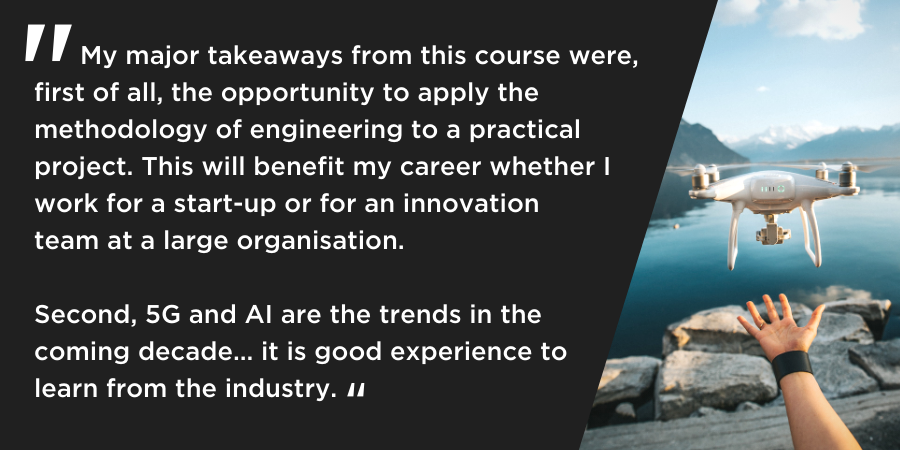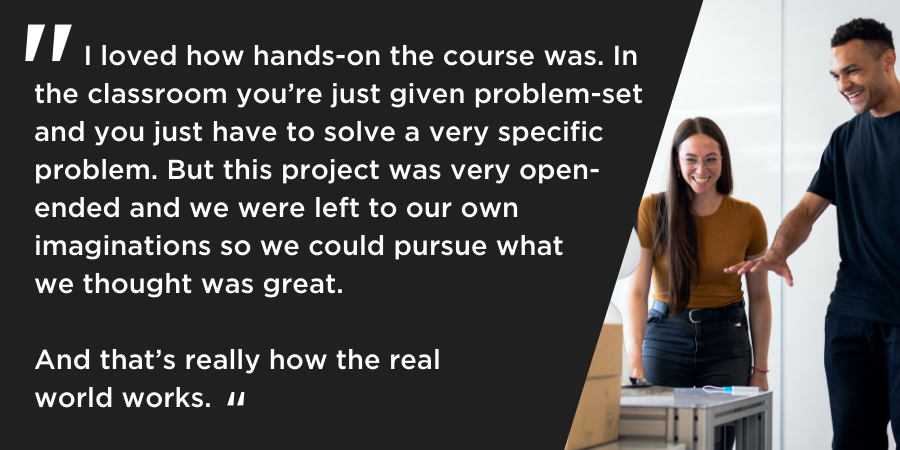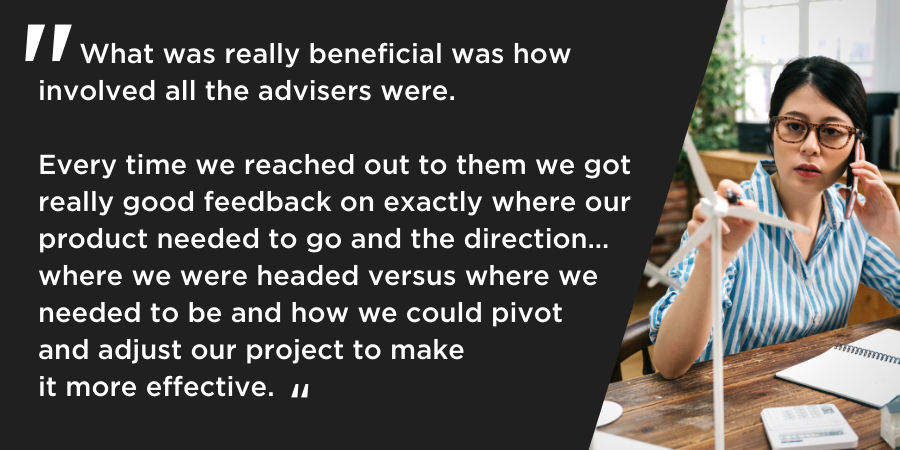The final session of spring 2020 Innovating on 5G Mobile Networks with AI course at UC Berkeley saw eight project teams present their findings to a team of judges from across academia and industry.
Find out more about these innovative and transformative projects:
A link between wildfires and power lines has been identified in the past several years. A report, issued by the California Department of Forestry and Fire Protection, noted that these fires could have occurred in part due to poor vegetation management, resulting in trees and branches coming into contact with power lines. Such was the case for California’s 2018 Camp Fire; the deadliest in the state’s history.
A group of six UC Berkeley students developed a solution called Drone 200 that will identify poor vegetation management and vastly reduce infrastructure-related fires by using 5G-enabled drones. Through an automated flight path and remote control via a low-latency 5G connection, these drones will collect video imagery of vegetation near power lines and use a computer vision algorithm to detect any potential fire hazards.
Without Drone 200, companies have to rely on field engineers to manually inspect the adjacent vegetation to over 250,000 miles of power lines, resulting in exorbitant costs.
Ultimately, Drone 200 will ensure that an incident as devastating as the Camp Fire will never happen again.
As of May 2020, there are almost 9 billion mobile connections around the globe. Mobile data has increased to 40EB per month, double that of two years ago. To counter this challenge, the number of small base stations in the world will reach 12 million by 2025, 6.5 million of which will be 5G base stations. On one hand, customers need a more stable and faster mobile network connection; on the other hand, telecommunication operators need to improve network operations.
The project, 5G Coverage Dynamics, intends to bridge the gap between operators and customers by building AI tools to improve operational efficiency. The product comprises an end-to-end system collecting network connection related data (motion, location, latency) from mobile devices. The data is collected in real-time and stored on the cloud; the team then integrated the data and developed a front-end web application, demonstrating a dynamic heat map to help operators determine the status (coverage and latency) of the network.
Machine learning was used in forecasting models to predict latency and user density, based on which operators could proactively customise their network services. The team envisions a 5G service platform that automates data collection from IoT devices and provides new applications based on information processing.
5G Dynamic Coverage is an effective tool for telecommunication industry to improve network services and customer satisfaction.
Passionate about healthcare, the team focused on 5G and AI to improve healthcare systems for the elderly at senior care centres. They strove to do this by conducting research on biomedical conditions that senior citizens often face and were inspired to develop a smartwatch app that could help track seniors in hopes of providing them with greater assistance during times of emergencies.
As the COVID-19 pandemic broke out, however, they realised that an even greater need for their product could be applied to the present hectic health climate. After brainstorming, they decided to design an app that would allow companies with essential workers to better track their employees’ health and determine their level of risk to the virus.
Moving forward, they ultimately hope to pitch the app, Blue Haiven, to these companies to help minimise the spread of the coronavirus and allow society to be freed from quarantine as soon as possible.
Exploring the potential for 5G & VR remotely controlled robots. The team created a VR environment for people to control robots remotely aiming to create safer, more convenient human interaction with robots in order to address multiple use cases such as remote surgery or ordnance disposal.
Digital ARt immerses gallery-goers within an artificial intelligence-backed personalised art experience. Upon entering the gallery, visitors receive a pair of AR goggles and a custom virtual gallery. The user can rate every art piece they see. A machine learning-based recommendation system then updates the virtual gallery to provide a personalised immersive experience. The founders of DigitalArt realised that 5G would allow for a realistic immersive AR experience.
The gallery’s experience is built upon 5G’s low latency and edge computing capabilities, which creates a constant stream of data to curate a personalised and immersive AR experience. Driven by a positive initial response to the gallery, the team envisions creating a global market space for digital artists, museum-goers, and art collectors.
This new medium of art leaps into the lucrative intersection of 3D art and augmented reality, which can streamline into the entertainment industry, video games, and other internet-based services in the future.
Because of California’s COVID-19 extended stay at home order, the team behind Digital ARt have made this experience open source.
As the human population continues to rise, the waste we create grows exponentially. The heart of waste management is the humble trash can. On college campuses and office campuses, people have neither the time nor the patience to deposit their trash in the right bin.
This team’s product will eliminate both the time and the decision-making of this process. A high-speed scanner allows users to scan their article of trash and then immediately notifies users which bin the trash should be deposited into. Furthermore, the bin keeps recycling facilities in the loop. In a protected system on the cloud, the data passing through the scanner will be uploaded to a website so that recycling facilities can obtain crucial data for each of their bins.
By boosting the user experience of the traditional garbage bin and by providing recycling companies with a way to better understand their incoming waste, the team believes our product is essential to the future of waste management.
There are only 24 hours in a day. We should spend that time efficiently, whether it’s getting our work done or spending it with loved ones. Crowd.ai has a solution that helps you get more time out of your day. Crowd.ai is an application that tells users how crowded their target destination is in real-time.
The application accomplishes this by collecting its users’ location data and utilising that to understand how crowded a location is before distributing how crowded that location is to the user. Privacy was of a huge concern from the engineering team so the engineers built their product so that only location data is collected and data is abstracted so that users only have access to how many people are at their target location.
During the process of building their application, the COVID-19 pandemic became prevalent and the Crowd.ai team immediately shifted their attention towards helping people during this time. The Crowd.ai team understood that supermarkets and grocery stores would be most crowded. They made their product feature supermarkets and grocery stores so that users are able to judge how long their grocery trip would take beforehand.
Utilising their application, immunocompromised users will be able to see how crowded their destination is before heading out in order to minimise their risk.
Imagine the scene. When an unexpected fire broke out in the Cal Memorial Stadium’s Fitness Center at 3am on Tuesday due to malfunctioning of a smartphone left behind, there was no one on-the-scene to call 911. As the fire was spreading, however, the intense heat began to trigger an alarm in the backend of the innovative detection platform of 5G.11, which received temperature signals from an IoT-enabled device in the room.
The 5G.11 platform successfully predicted the fire, and immediately alerted local fire stations by sending a report and a recommendation on how to address the situation using its artificial intelligence. In response, the firemen promptly dispatched themselves and began their mission. Thus, the fire in the Fitness Center was extinguished before it became a major problem.
“It is a groundbreaker,” says a fireman on-the-scene. “Without 5G.11, we would have never been able to identify this fire as quickly as we did and before it became a much bigger problem. Moreover, the platform provided us and our command center with essential information that allowed us to coordinate and respond most efficiently.”
Built by UC Berkeley and NUS students passionate about leveraging 5G and AI to augment the old 911 emergency system, 5G.11 is a platform that employs new technologies in 5G, AI, and IoT devices.
The team expects this to be the next generation of 911 response in the United States.


